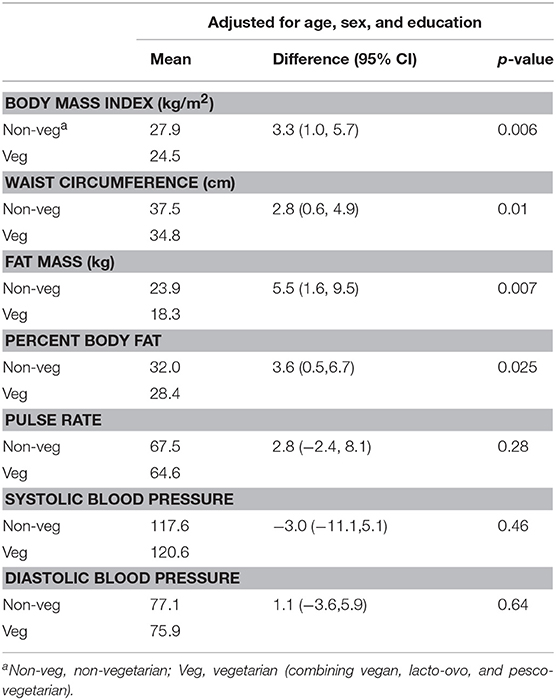
An April 2019 study 1 looked for dietary reasons that would account for the shockingly high rate of obesity and cardio-metabolic diseases within the US Hispanic and Latino population 2 .
Blog Contents
The study
The Adventist Multi-ethnic Nutrition Study (AMEN) enrolled 74 Seventh-day Adventists from five Hispanic and Latino churches within a 20 mile radius of Loma Linda, CA into a cross-sectional study of diet and health. The information analysed was based on questionnaires, anthropometrics 3 and biomarkers 4 . By comparing US Hispanic and Latino omnivores with a similar plant-based population (namely, Hispanic and Latino vegetarian/vegan Seventh-day Adventists), the researchers hoped to find out whether better health generally found in the latter group could be attributed to their continued adherence to a plant-based diet. Particular attention was paid to differences in adiposity and adiposity-related biomarkers between the two groups.
Study findings
It appears that the reason US Hispanic and Latino populations experience such high rates of obesity and cardio-metabolic disease is largely down to their transition towards the SAD (Standard American Diet) and away from traditional Hispanic and Latino diets that emphasised whole plant foods, such as were still consumed by the vegetarian/vegan Seventh-day Adventists included in this study.
When compared with the general non-vegetarian Hispanic and Latino population, vegetarian/vegan dietary patterns within the Seventh-day Adventist Hispanic and Latino population were associated with:
- significantly lower BMI (24.5 kg/m2 vs. 27.9 kg/m2, p = 0.006) 5
- significantly lower waist circumference (34.8 cm vs. 37.5 cm, p = 0.01)
- significantly lower fat mass (18.3 kg vs. 23.9 kg, p = 0.007)
Comparative results can be seen in the following table.

These findings are consistent with previous studies that have looked at other populations, including:
Traditional Latin American diets
There’s a rich cultural tradition of diverse regional plant foods within traditional Latin America cuisine:
- the Mexican Tarahumara Indians traditionally ate a diet of beans, corn, and squash and very little meat – a pattern associated with lower risk of cardiometabolic disease 12 . The risks are significantly increased when the Tarahumara change to the typical US diet 13 .
- Peruvian and Brazilian populations that follow traditional cultural choices which contain high amounts of plant foods have lower rates of hypertension, dyslipidemia, and obesity when compared to omnivores 14 .
The researchers consider that encouraging populations to re-introduce healthy plant foods, which have long-held and strong roots in their cultural heritage, is a potentially useful means of achieving high impact health interventions.
Study conclusions
Plant-based eating as practised by US-based Hispanic and Latino Seventh-day Adventists is associated with relatively healthy BMI15 . The study concludes that further research is needed to characterise the precise type of diet that should be recommended for use in obesity-related interventions among Hispanic and Latinos in the US.
Final thoughts
This study adds to the already considerable body of evidence suggesting that naturally-low-fat plant-based diets are the way to go if you want to remain healthy – particularly if you want to ensure that obesity and obesity-related diseases don’t reduce both the quality and length of your life. Of course, the more wholefood, non-processed the diet, the better. This would, I suspect, result in much improved biomarkers when compared, not only with the above omnivores, but also with the vegetarian/vegan group reviewed within this study – a group which included lacto-ovo vegetarians and pescotarians.
Additionally, I could not get a clear picture of whether and how this study drew distinctions between whole and processed plant foods, with the latter consistently failing to provide the health benefits of the former 16 .
From whatever perspective you may look, when it comes to obesity, there’s a weight of truth in the saying: “The fat you eat is the fat you wear.”
References & notes
- Plant-Based Diets Are Associated With Lower Adiposity Levels Among Hispanic/Latino Adults in the Adventist Multi-Ethnic Nutrition (AMEN) Study. Singh PN, Jaceldo-Siegl K, Shih W, Collado N, Le LT, Silguero K, Estevez D, Jordan M, Flores H, Hayes-Bautista DE, McCarthy WJ. Front Nutr. 2019 Apr 9;6:34. doi: 10.3389/fnut.2019.00034. eCollection 2019. PMID: 31024919. [↩]
- Hispanic and Latino are often used interchangeably though they actually mean two different things. Hispanic refers to people who speak Spanish and/or are descended from Spanish-speaking populations, while Latino refers to people who are from or descended from people from Latin America. [↩]
- Anthropometry refers to the measurement of the human individual. An early tool of physical anthropology, it has been used for identification, for the purposes of understanding human physical variation. [↩]
- What are biomarkers? [↩]
- The p-value is a number between 0 and 1 and os interpreted in the following way: A small p-value (typically ≤ 0.05) indicates strong evidence against the null hypothesis – that is, that there is no evidence to support a relationship, so you reject the null hypothesis and accept that there is a potentially causal relationship. Basically, the smaller the number, the more evidence there is for some form of relationship between the two or more elements under discussion. In this case, 0.006 indicates that there is a strong probability that a lower BMI is associated with a vegan/vegetarian diet. [↩]
- Vang A, Singh PN, Lee JW, Haddad EH, Brinegar CH. Meats, processed meats, obesity, weight gain and occurrence of diabetes among adults: findings from Adventist Health Studies. Ann Nutr Metab. (2008) 52:96–104. doi: 10.1159/000121365 [↩]
- Singh PN, Sabate J, Fraser GE. Does low meat consumption increase life expectancy in humans? Am J Clin Nutr. (2003) 78(Suppl. 3):526S−32S. doi: 10.1093/ajcn/78.3.526S [↩]
- Tonstad S, Butler T, Yan R, Fraser GE. Type of vegetarian diet, body weight, and prevalence of type 2 diabetes. Diabetes Care. (2009) 32:791–6. doi: 10.2337/dc08-1886 [↩] [↩]
- Singh PN, Clark RW, Herring P, Sabate J, Shavlik D, Fraser GE. Obesity and life expectancy among long-lived Black adults. J Gerontol A Biol Sci Med Sci. (2014) 69:63–72. doi: 10.1093/gerona/glt049 [↩]
- Akbar JA, Jaceldo-Siegl K, Fraser G, Herring RP, Yancey A. The contribution of soul and Caribbean foods to nutrient intake in a sample of Blacks of US and Caribbean descent in the Adventist Health Study-2: a pilot study. Ethn Dis. (2007) 17:244–9. doi: 10.1093/aje/163.suppl_11.S31-c [↩]
- Singh PN, Arthur KN, Orlich MJ, James W, Purty A, Job JS, et al. Global epidemiology of obesity, vegetarian dietary patterns, and noncommunicable disease in Asian Indians. Am J Clin Nutr. (2014) 100 (Suppl. 1):359S−64S. doi: 10.3945/ajcn.113.071571 [↩]
- Connor WE, Cerqueira MT, Connor RW, Wallace RB, Malinow MR, Casdorph HR. The plasma lipids, lipoproteins, and diet of the Tarahumara indians of Mexico. Am J Clin Nutr. (1978) 31:1131–42. doi: 10.1093/ajcn/31.7.1131 [↩]
- McMurry MP, Cerqueira MT, Connor SL, Connor WE. Changes in lipid and lipoprotein levels and body weight in Tarahumara Indians after consumption of an affluent diet. N Engl J Med. (1991) 325:1704–8. doi: 10.1056/NEJM199112123252405 [↩]
- Navarro JA, Caramelli B. Vegetarians from latin america. Am J Cardiol. (2010) 105:902. doi: 10.1016/j.amjcard.2009.10.031 [↩]
- The American Heart Association defines a healthy BMI as 18.5 kg/m² to 24.9 kg/m². [↩]
- All Ultra-Processed Foods Linked to Increased Cancer Links [↩]